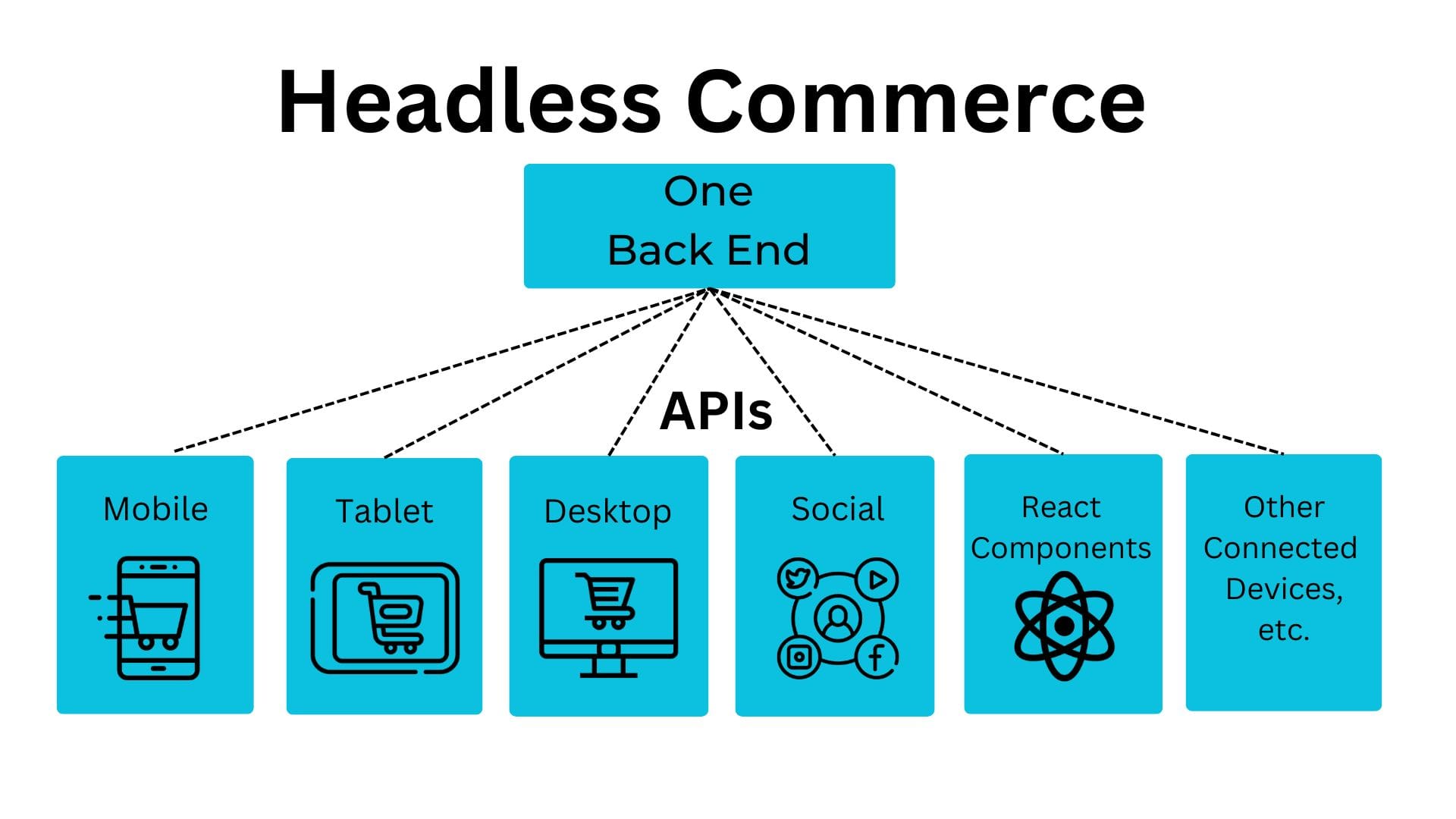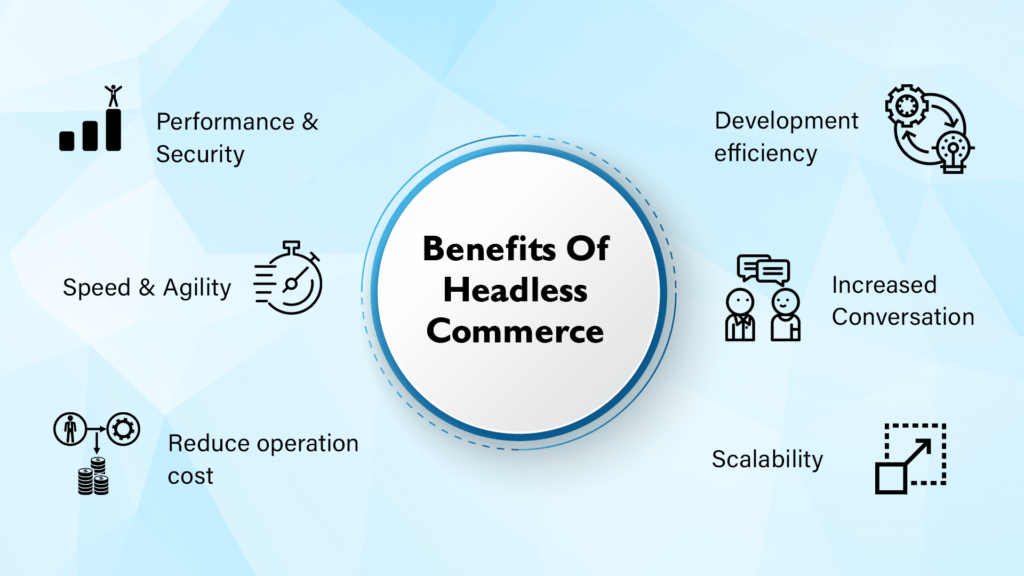Introduction to Headless Commerce
Headless commerce is shaking up the world of online shopping. It offers new ways to sell and buy that are faster, more flexible, and more efficient.
What is Headless Commerce?
Headless commerce splits an online store into two parts: the front end and the back end.

- Front end: This is what customers see and interact with, like the website or app.
- Back end: This is where all the store’s operations happen, such as managing products and processing orders.
Why is Headless Commerce Important?
In this section, you’ll find about the importance of headless commerce.
Flexibility
Headless commerce allows businesses to update the front end without touching the back end. This means faster changes and better customer experiences.
Customization
Companies can create unique shopping experiences. This level of customization is hard to achieve with traditional setups.
Speed
Loading times are often quicker with headless commerce. Faster websites keep customers happy and can lead to more sales.
Integration
It’s easier to connect with other systems, like CRM tools or social media. This makes it simple to manage everything in one place.
Scalability
As a business grows, headless commerce can scale with it. Adding new features or expanding to new markets becomes simpler and quicker.
Security
Since the front end and back end are separate, a security issue in one won’t necessarily affect the other. This added layer of protection is vital for online stores.
Key Concepts in Headless Commerce
Headless commerce is transforming how online stores operate. Let’s dive into some key ideas that make this approach powerful and flexible.

API (Application Programming Interface)
An API lets different parts of an online store talk to each other. It’s like a bridge that connects the front end and the back end.
- Front end: The part users see and interact with.
- Back end: The part that manages data and processes.
Decoupling in E-Commerce
Decoupling means separating the front end and back end of an online store. They operate independently but still communicate through APIs.
Benefits of Decoupling
The benefits of decoupling are the following:
- Speed: Faster updates and loading times.
- Customization: Easier to create unique shopping experiences.
- Scalability: Simpler to add new features and grow the store.
- Security: Improved protection since a problem in one part doesn’t affect the other.
Microservices Architecture
Microservices are small, independent services that handle different parts of an online store. Each service has a specific job, like managing inventory or processing payments.

Advantages of Microservices
The advantages of microservices architecture are the following:
- Independence: Each microservice works on its own, making it easier to update or fix.
- Scalability: Add or improve services as your store grows.
- Efficiency: Focus on specific tasks, which makes the system faster and more reliable.
Examples of Microservices
Now, let’s see the examples of microservices are the following:
- Inventory management: Keeps track of products and stock levels.
- Payment processing: Handles transactions securely and efficiently.
- Customer service: Manages customer inquiries and support tickets.
Benefits of Headless Commerce
The benefits of headless commerce are numerous, So let’s check the key benefits:

Flexibility and Customization
First benefits of headless commerce is flexibility and customization:
Flexibility
The flexibility is all about:
- Separate Front End and Back End: You can update the look and feel of your store without touching the backend.
- Quick Changes: Make fast updates to your website or app. This keeps your store fresh and engaging.
Customization
The customization talks about:
- Unique Experiences: Create a shopping experience that stands out.
- Tailored Solutions: Customize features to fit your business needs. This is easier than with traditional setups.
Improved Performance and Speed
Next benefits of headless commerce is improved performance and speeds:
Faster Loading Times
The faster leading times include:
- Speed Matters: A fast website keeps customers happy and can boost sales.
- Better User Experience: Quick load times mean smoother browsing and shopping.
Efficient Operations
Efficient operations leads to:
- Streamlined Processes: Headless commerce allows for more efficient data management.
- Reduced Downtime: Updates and maintenance can be done without disrupting the shopping experience.
Enhanced Customer Experience
Third key benefits of headless commerce is enhancing customer experience:
Personalization
Personalization includes:
- Tailored Content: Show products and offers based on customer behavior and preferences.
- Engaging Interactions: Use data to create a more personalized shopping journey.
Seamless Experience
Seamless customer experience is about:
- Consistent Branding: Ensure a uniform look and feel across all platforms.
- Smooth Navigation: Easy-to-use interfaces keep customers coming back.
Scalability and Future-Proofing
Scalability and future-proofing is another benefits of headless commerce:
Scalability
The scalability includes:
- Grow with Ease: As your business grows, your tech can grow with you.
- Add Features: Easily integrate new tools and services.
Future-Proofing
The future-proofing includes:
- Stay Ahead: Quickly adapt to new trends and technologies.
- Long-Term Investment: A headless setup can save money and effort in the long run by being adaptable and robust.
Omnichannel Capabilities
Last key benefits of headless commerce is omnichannel capabilities:
Reach Customers Everywhere
Reaching customer everywhere is done through:
- Multiple Platforms: Sell on websites, apps, social media, and even in-store kiosks.
- Unified Experience: Provide a seamless shopping experience across all channels.
Integration
To reach everywhere connectivity is essential and that is possible with integration:
- Connect Everything: Easily integrate with other systems, like CRM and marketing tools.
- Consistent Data: Keep data synchronized across all platforms for better management and insights.
Frequently Asked Questions (FAQs)
What is headless commerce and how does it differ from traditional e-commerce platforms?
Headless commerce separates the front-end presentation layer from the back-end e-commerce functionality, offering greater customization and flexibility compared to traditional e-commerce systems.
What are the main advantages of adopting a headless commerce approach?
Key advantages include omnichannel experiences, faster go-to-market, personalization, scalability, and the opportunity to use modern front-end technologies to enhance user experience.
How does headless commerce impact the user experience?
It allows for seamless and consistent interactions across various touchpoints, providing a more personalized, engaging, and responsive user experience that meets modern consumers' expectations.
Can headless commerce integrate with existing business systems?
Yes, headless commerce is designed to be API-driven, which facilitates integration with various business systems such as CRM, ERP, PIM, and marketing automation tools.
Is migrating to headless commerce a complex process?
The complexity varies depending on the business's existing setup and the chosen solutions. It typically requires strategic planning, a skilled development team, and possibly some downtime.
